

IELTS AC Reading: Cambridge 13 Test 4; Reading Passage 3: Book Review; with best solutions and detailed explanations
This IELTS Reading post deals with Cambridge 13 Reading Test 4 Passage 3 which is entitled ‘Book Review’ . This post discusses all the answers and solutions for Reading Passage 3. This is another intended post for candidates who have the most difficulties in finding and understanding IELTS Reading Answers. This post can simply guide you the best to figure out every Reading answer without trouble. Finding IELTS Reading answers is a step-by-step routine and I hope this post can assist you in this topic.
Cambridge 13 Reading Test 4 Passage 3 :
The headline of the passage: book review.
Questions 27-29: (Multiple Choice Questions)
[ Multiple choice questions are a common type of question set in the IELTS Reading test. It is also found in the Listening test. Most of the time, they come with four options but sometimes there are three options. Candidates need to work hard for this type of question because this may confuse them easily in passage 2 or passage 3. There will be long answers for each question, so they may kill valuable time. So, a quick reading or skimming technique might come handy here. Remember that answers in 3 options out of 4 will be very close. So, vocabulary power will help a lot to choose the best answer.]
[ TIPS: Skimming is the best reading technique. You need not understand every word here. Just try to gather the gist of the sentences. That’s all. Read quickly and don’t stop until you finish each sentence.]
Question 27: What is the reviewer’s attitude to advocates of positive psychology?
Keywords for this question: reviewer’s attitude, advocates of positive psychology
We can find the reference to ‘positive psychology’ in line 6 of paragraph no. 1. Here, the writer defines ‘positive psychology’. However, the mention of ‘advocates of positive psychology’ is found in line 12 of paragraph no. 2. The writer says in lines 2-5 about them, “Those who think in this way are oblivious to the vast philosophical literature in which the meaning and value of happiness have been explored and questioned, and write as if nothing of any importance had been thought on the subject until it came to their attention .”
Here, as if nothing of any importance had been thought on the subject until it came to their attention means they are actually ignorant about the ideas which they should consider.
*The word oblivious also means unaware or ignorant .
So, the answer is: D
Question 28: The reviewer refers to the Greek philosopher Aristotle in order to suggest that happiness
Keywords for this question: Aristotle,
We find the mention of Greek philosopher Aristotle in line 7 of paragraph no. 2. So, we need to scan the lines carefully. Here, the writer says in lines 6-10, “For Bentham it was obvious that the human good consists of pleasure and the absence of pain. The Greek philosopher Aristotle may have identified happiness with self-realisation in the 4th century,. .. . .. .. . but for Bentham all this was mere metaphysics or fiction.” The writer discusses here that Bentham considers happiness as only with pleasure and with the absence of pain. But for Aristotle it was not only pleasure and absence of pain. Rather, it was something that could be identified by self-realisation, which may not seem correct all the time.
So, the answer is: A
Question 29: According to Davies, Bentham’s suggestion for linking the price of goods to happiness was significant because
Keywords for this question: Davies, Bentham’s suggestion, linking, price of goods,
The answer is in the fourth paragraph, where the writer talks about price of goods. Here, in the last few lines, the writer says, “By associating money so closely to inner experience, Davies writes, Bentham ‘ set the stage for the entangling of psychological research and capitalism that would shape the business practices of the twentieth century’.” The writer explains here that Bentham had associated money or price of goods with inner experience and thus made a connection between work and human psychology.
So, the answer is: B
Questions 30-34: (Summary completion with NO MORE THAN ONE WORD)
[In this kind of question candidates are given a summary for one, two or three paragraphs with some fill in the blanks questions. As these are fill in the blanks or gaps, there is a condition of writing no more than ONE, TWO, or THREE words for each answer and candidates must maintain this condition. Candidates need to find out the related paragraphs by correctly studying the keywords form the questions. Then, they should follow the steps of finding answers to fill in the gaps.]
Title of the summary: Jeremy Bentham
Question 30: In the 1790s he suggested a type of technology to improve _________ for different Government departments.
Keywords for this question: 1790s, technology, to improve, different Government departments
The answer to this question lies in paragraph no. 3, lines 6-7 where the author writes, “In the 1790s, he wrote to the Home Office suggesting that the departments of government be linked together through a set of ‘conversation tubes’.”
These lines indicate that Bentham proposed to the Home office that Governmental departments should establish communication with Home office through ‘conversation tubes’.
So, the answer is: F (communication)
Question 31: He developed a new way of printing banknotes to increase ________
Keywords for this question: developed, new way, printing banknotes
In paragraph no. 3, the author says in lines 8-9, “… and to the Bank of England with a design for a printing device that could produce unforgeable banknotes ”. Here, unforgeable means something that cannot be forged or falsified or falsified. So, this means that Bentham actually developed a new way of printing banknotes to increase safety or security .
So, the answer is: B (security)
Question 32: and also designed a method for the ________ of food.
Keywords for this question: designed, method, food
The reference to food can be found in lines 9-10 of paragraph no. 3. “He drew up plans for a “frigidarium” to keep provisions such as meat, fish, fruit and vegetables fresh.” These lines directly refer to the preservation of food .
So, the answer is: G (preservation)
Question 33: He also drew up plans for a prison which allowed the _______ of prisoners at all times, … .. . .
Keywords for this question: drew up plans, prison, allowed, prisoners
The answer is in lines 10-12 of paragraph no. 3. Here, the author writes, “He celebrated design for a prison to be known as ‘Panoptieon’, in which prisoners would be kept in solitary confinement while being visible at all time to the guards, ….” Here, while being visible = under observation
So, the answer is: E (observation)
Question 34: when researching happiness, he investigated possibilities for its ________, and suggested some methods of doing this.
Keywords for this question: investigated, possibilities, suggested some methods
The answer to this question is also found in lines 1-2 of Paragraph no. 4. “If happiness is to be regarded as a science, it has to be measured ,….” This means Bentham suggested the methods of taking measurement .
So, the answer is: A (measurement)
Questions 35-40 (YES/NO/NOT GIVEN):
[In this type of question, candidates are asked to find out whether:
The statement in the question matches the claim of the writer in the text- YES The statement in the question contradicts the claim of the writer in the text- NO The statement in the question has no clear connection with the account in the text- NOT GIVEN ]
[TIPS: For this type of question, you can divide each statement into three independent pieces and make your way through with the answer.]
Question 35: One strength of The Happiness Industry is its discussion of the relationship between psychology and economics.
Keywords for this question: The Happiness Industry, discussion, relationship, psychology, economics
The answer can be found in the first few lines of paragraph no. 5 “The Happiness Industry describes how the project of a science of happiness has become integral to capitalism . We learn much that is interesting about how economic problems are being redefined and treated as psychological maladies ”. So, it is clear from these lines that there is a strong relationship between psychology and economics.
So, the answer is: YES
Question 36: It is more difficult to measure some emotions than others.
Keywords for this question: difficult to measure, some emotions,
The answer cannot be found in this passage. There is a sentence in paragraph 5 about the feeling of pleasure and displeasure that can be measured which gives further information for research management and advertising. “In addition, Davies shows how the belief that inner states of pleasure and displeasure can be objectively measured has informed management studies and advertising.” But it is not related to this question.
So, the answer is : NOT GIVEN
Question 37: Watson’s ideas on behaviourism were supported by research on humans he carried out before 1915.
Keywords for this question: Watson’s ideas, behaviuorism, supported, research, humans, before 1915
The answer is found in lines 7-9 of paragraph no. 5 which directly contradicts the given question. “When he became president of the American Psychological Association in 1915, he had never even studied a single human being: his research had been confined to experiments on white rats.”
This means Watson’s experiments were on rats , not on humans.
So, the answer is: NO
Question 38: Watson’s ideas have been most influential on governments outside America.
Keywords for this question: Watson’s ideas, most influential, governments outside America
In paragraph 5 there is no information about the impact of Watson’s ideas on countries outside the USA.
So, the answer is: NOT GIVEN
Question 39: The need for happiness is linked to industrialization.
Keywords for this question: need for happiness, linked, industrialization
The answer to this question can be found in the opening sentence paragraph no. 6 which talks about the need for happiness that is connected with labour market. “ Modern industrial societies appear to need the possibility of ever-increasing happiness to motivate them in their labours.” This is a clear match with the question.
Question 40: A main aim of government should be to increase the happiness of the population.
Keywords for this question: main aim, government, increase, happiness of the population
The writer says in lines 2-3 in paragraph no. 6, “But whatever its intellectual pedigree, the idea that governments should be responsible for promoting happiness is always a threat to human freedom .”
Our question asks to find out the aim. But we find out that this is a comment from the author, not a statement on the aim of government.
So, the answer is: NO
Please leave your comments if you like this post or have any queries about it.
Click here for solutions to Cambridge 13 Test 4 Reading Passage 1
Click here for solutions to Cambridge 13 Test 4 Reading Passage 2
36 thoughts on “ IELTS AC Reading: Cambridge 13 Test 4; Reading Passage 3: Book Review; with best solutions and detailed explanations ”
- Pingback: IELTS academic Reading: Cambridge 13 Test 4, Reading passage 2; Saving the soil, with best solutions and easy explanations | IELTS Deal
Why the answer of 40 is not “Not Given”? In the sentence, it doesn’t mention government’s aim at all
I agree with you 🙂 The question designers of IELTS tests design the tests in a way that even the natives connot answer them correctly!!! I don’t understand it is an analytical test or a test for assessment of our English! I don’t comprehend why they are taking so hard! How many languages except their mother language do they know which expect us know English as well as our mother tongue?!
Sorry:( I am a little angry about the vain rigidity that the world has considered for people!
Hahahahhaha, wonderful???
Totally agree!
Initially, I also struggled to understand the explanation for question 40. After carefully scanning again, I finally found out the problem. We suppose to find the synonym of the key word ‘main aim of the government’ which is located in Paragraph 5, line 10 – ‘the goal of governments’. Reading that sentence, we’ll see that the main aim here is to change the behaviour of the population , not to increase their happiness.
Omg thank u
Government has several aims, and even if one of them is changing the behavior of the population, we still can not be sure whether increasing their happiness is their main aim or not, so the detail cant be in that passage
Just to for fun I guess, cause’ it is wrong answer to make a student have a mistake they say the answer is wrong!
- Pingback: IELTS Academic Reading: Cambridge 13 Test 4, Reading passage 1; Cutty Sark: the fastest sailing ship of all time; with best solutions and easy explanations | IELTS Deal
2 mistakes on ques 6 and 40 🙂
May I ask about the mistakes in details please?
I also found some difficulty in que 6 bcz I think it’s a true but it is false..!
Thanks for explanation But why the q 38 is notgiven ? It is obviously said that :In Britain
But it doesn’t mention ‘most influential’
Why some of the passage 3 in book 12 and 13 are too hard?
Hi thank you for all your information with nice flow to compare frequentist vs bayesian approach. I will look forward to next part of the tutorials!!
You’re most welcome!
The ans of third question should be false
Can you explain que no 37 ..here, they are talking about’ before 1915′ also.. But in passage ,it is mentioned that ‘ he became president in 1915’..
This means Watson’s experiments were on rats, not on humans.
I am from Vietnam and I wish I could do something for you. Since I started to do the tests, this web has helped me a lot
Hello, Thank you for your kind thoughts. My son is extremely sick. As a father, it gives me such a pain to watch him go through this. Please pray for my son.
According to the author’s analysis, the answer 40 seems like a ‘NG’. However, in the last paragraph, the writer gives his own comment that he is not agree with the idea that government should be responsible for promoting happiness, which is just what the question 40 claims. That’s why the answer 40 is a ‘N’ not a ‘NG’, cuz it contradicts the claims of the writer.
How the answer of 35 is yes? AND does it has mentioned that discussing relationship between psychology and economics is the strenght part of The happiness industry?
Thanks a lot.This was helpful
Good day! I always use your system to check my mistakes. The system is perfectly organised. Please, can you give me some advice about reading? I do most of the reading practices but the score is always the same 5.5 or 6.
Hello, I think you can register for some 1-to-1 classes with me. Here, I can help you solve your problems directly. If that sounds good, let me know. Here’s my email: [email protected]
- Pingback: Book Review Reading Answers? The 117 Top Answers - vi-magento.com
- Pingback: IELTS academic Reading: Cambridge 13 Test 4, Reading passage 2; Saving the soil, with best solutions and easy explanations - IELTS Deal
Many thanks.
Could you explain why the answer for 36 question isn’t No. Could you explain why the answer for 36 isn’t No
because there did not mentioned about emotions, only emphasized pleasure and displeasure
Leave a Reply Cancel reply
Your email address will not be published. Required fields are marked *

Academic IELTS Reading: Test 2 Passage 1; The Dead Sea Scrolls; with top solutions and best explanations
This Academic IELTS Reading post focuses on solutions to an IELTS Reading Test 2 passage 1 that has a passage titled ‘The Dead Sea Scrolls’. This is a targeted post for Academic IELTS candidates who have major problems locating and understanding Reading Answers in the AC module. This post can guide you the best to understand […]

Academic IELTS Reading: Test 1 Reading passage 3; To catch a king; with best solutions and explanations
This Academic IELTS Reading post focuses on solutions to an IELTS Reading Test 1 Reading Passage 3 titled ‘To catch a king’. This is a targeted post for IELTS candidates who have great problems finding out and understanding Reading Answers in the AC module. This post can guide you the best to understand every Reading answer […]
Advertisement
Supported by
- Share full article
By Diana Silver
- Feb. 11, 2011
Edward Glaeser, a Harvard professor of economics, has spent several decades investigating the role cities play in fostering human achievement. In “Triumph of the City,” he has embedded his findings in a book that is at once polymathic and vibrant.
Glaeser’s essential contention is that “cities magnify humanity’s strengths.” They spur innovation by facilitating face-to-face interaction, they attract talent and sharpen it through competition, they encourage entrepreneurship, and they allow for social and economic mobility. Glaeser takes us on a world tour of urban economics, collecting passport stamps in Athens, London, Tokyo, Bangalore, Kinshasa, Houston, Boston, Singapore and Vancouver. Along the way, he explains how urban density contributed to the birth of restaurants, why supermarket check-out clerks demonstrate the competitive advantage such density confers and how the birth of Def Jam Records illustrates the way cities spur artistic innovation. Here, his enthusiasm for cities is refreshing.
Glaeser’s got some tough words for poorly reasoned public policies that feed suburban living: federal highway programs, the mortgage tax deduction, low gas prices. While he understands the lure of big houses and lush lawns, he’s against subsidizing them. And he chastises city planners in Paris and Mumbai, making a passionate argument for building up — and up and up.

Though he admires Jane Jacobs’s insights into the virtues of mixing residential and retail together, he thinks her prescription for small-scale neighborhoods is wrongheaded. He’d much rather see neighborhoods of skyscrapers than acres of suburban developments. Greater density is the goal: more people means more possibility. Even when writing about the developing world, Glaeser is unfazed by threats of overwhelmed sanitation systems, unsafe housing or impossible congestion. These, he suggests, are problems more readily solved than the environmental consequences of sprawling suburban life.
Glaeser is scathing in denouncing local conservationists for their devotion to “leafy suburbs,” which he sees as being at odds with true environmentalism. Reminding us that even Thoreau benefited from association with a circle of urban intellectuals, he insists that suburbanization is producing an ecological disaster. Growth that’s restricted in temperate areas like coastal California is pushed into intemperate ones like Las Vegas, where air-conditioning is leading to a carbon emissions nightmare. What will happen, he asks, if China and India emulate us? Paradoxically, fighting for local green space in the Bay Area undermines our ability to be global environmental activists.
Clearly, Glaeser loves an argument, and he’s a wonderful guide into one. “Triumph of the City” is bursting with insights and policy proposals to debate. Sometimes that’s a bit of a problem: there’s a lot of policy in this book, but not a lot of politics. It’s about ideas, not implementation. Some of those ideas may strike you as problematic: the increasing density he credits Atlanta with has been accompanied by an explosion of suburban sprawl. Others, like tilting the benefits of the tax system away from suburbanites and toward city residents, may sound absolutely unrealizable. And still others, like his advice to cities in decline to “shrink to greatness,” seem a little tone deaf, especially since those cities are steadily losing the skills and talent to find that greatness.
No matter though. If separating ideas from implementation can leave you a little lightheaded, you’ll still walk away dazzled by the greatness of cities and fascinated by this writer’s nimble mind.
TRIUMPH OF THE CITY
How our greatest invention makes us richer, smarter, greener, healthier, and happier.
By Edward Glaeser
Illustrated. 338 pp. The Penguin Press. $29.95.
Diana Silver is an assistant professor of public health at the Steinhardt School of New York University.
Explore More in Books
Want to know about the best books to read and the latest news start here..
Salman Rushdie’s new memoir, “Knife,” addresses the attack that maimed him in 2022, and pays tribute to his wife who saw him through .
Recent books by Allen Bratton, Daniel Lefferts and Garrard Conley depict gay Christian characters not usually seen in queer literature.
What can fiction tell us about the apocalypse? The writer Ayana Mathis finds unexpected hope in novels of crisis by Ling Ma, Jenny Offill and Jesmyn Ward .
At 28, the poet Tayi Tibble has been hailed as the funny, fresh and immensely skilled voice of a generation in Māori writing .
Amid a surge in book bans, the most challenged books in the United States in 2023 continued to focus on the experiences of L.G.B.T.Q. people or explore themes of race.
Each week, top authors and critics join the Book Review’s podcast to talk about the latest news in the literary world. Listen here .
- No category
Triumph of the City - SuperSummary Study Guide
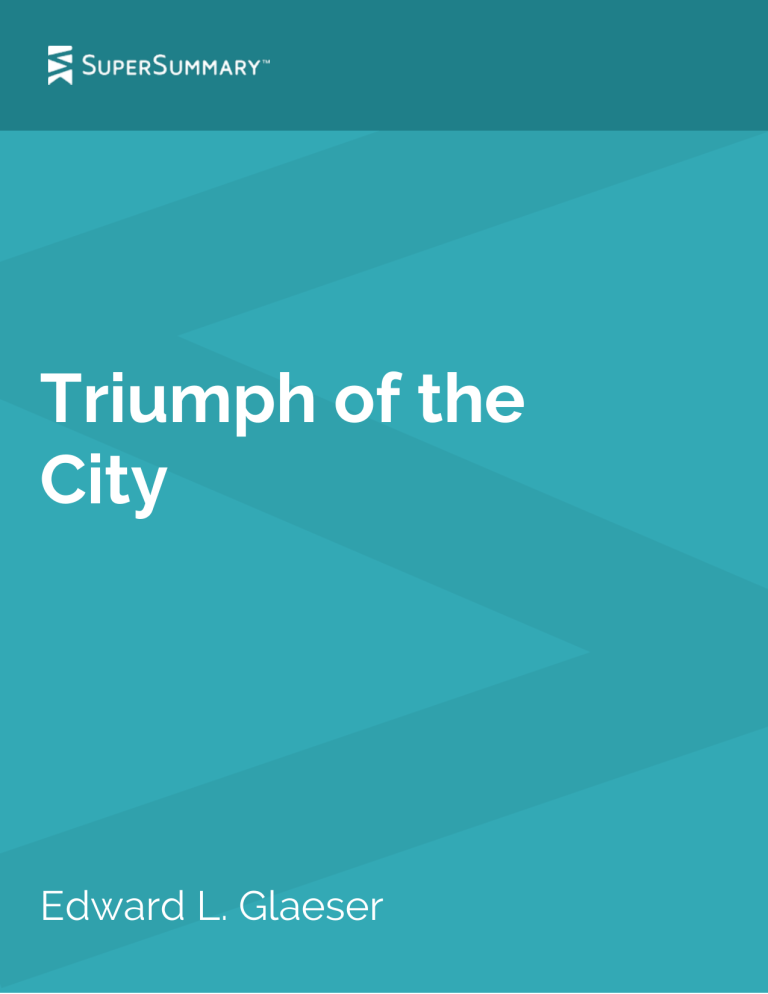
Related documents

Add this document to collection(s)
You can add this document to your study collection(s)
Add this document to saved
You can add this document to your saved list
Suggest us how to improve StudyLib
(For complaints, use another form )
Input it if you want to receive answer

Here & Now
The Academy of Urbanism Journal
REVIEW: Triumph of the City, Edward Glaeser

Ten Years after its original publication Nicholas Falk rereads this hugely influential book following a visit to Coventry, finding much wisdom but remaining frustrated that we still find these seemingly obvious ideas so difficult to implement.
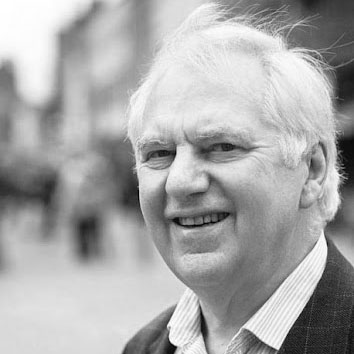
With chapter titles such as How were the tenements tamed? and Is London a luxury resort? he challenges the conventional wisdom and is particularly critical of declining cities that think they can build their way to success (like Coventry?). He clearly delights in the restaurants and places of entertainment that density and diversity make viable and provides a wealth of statistical facts and a few strong images to show that it is cities that now provide the wealth of nations because ‘Cities enable the creativity that makes humanity shine more brightly’ .
As a Harvard economist he is good at marshalling statistical data to prove that success today is about creating places where people with choice want to live. He argues it is people, not buildings, that create cities, and that density helps ideas to move. But density also consumes far less energy, especially as far as transport is concerned, and hence cities are more sustainable than suburbs. He calculates that if carbon emissions in China and India rose to American levels, the world’s carbon consumption would increase by 139%, even if their populations stayed the same.
Hence to me the most powerful and relevant sections are where he shows how New York, which in the 1970s was crime-ridden, is now a great place to live, In contrast in California, where environmentalists have largely managed to prevent large scale development, housing is quite unaffordable and homelessness rife. He points out that ‘cities attract poor people because they’re good places for poor people to live.’ But there is a vast difference between the highly productive slums of Dharavi in Mumbai and the downtown area of San Francisco, with people on the streets sleeping in tents and bus shelters.
‘Cities enable the creativity that makes humanity shine more brightly’. Edward Glaeser
Most of his examples are taken from the very largest of cities, and from cities that thrive on selling information. He is rather dismissive of heritage, except in the case of Paris, saying that the number of listed buildings should be limited. While generally reinforcing and extending what Jane Jacobs wrote in The Economy of Cities he is convinced that to cope with growth cities need to go high, supporting Ken Livingstone against the Prince of Wales in some fine passages.
In my view he underplays the importance of social capital, of the associations people build up by being able to walk around familiar places and relate to their neighbours or shop keepers. This is probably because, like many fine economists, he fails to appreciate the distortion and corruption in many property markets that lead to large areas remaining sterile while developers and their advisors seek to build ever higher. Nor does he appreciate the extra costs of construction and maintenance that result when he writes about What’s so great about skyscrapers?
He would have done better to return to Leipzig, for example, to see how they have refurbished most of their buildings while creating a great water park in the area once scarred by coal and chemical industries. Despite losing 90% of their manufacturing jobs after reunification, the city is now a joy to visit (as the AoU Award nomination explains).
Alas Coventry cannot be held up as a good example of regeneration despite the efforts of its council and regeneration agencies. It remains in the thrall of the car , the pedestrianised shopping centre feels lifeless, perhaps because the lost housing around it was never replaced. The city’s bombing was seen as ‘a blessing in disguise’, as David Rudlin recounts in Climax City . The city’s planners were far more ruthless than the Luftwaffe, and of the 240 timber framed buildings that survived the war, only 100 were standing in 1958 and by 1965 it was down to just 34. The motor industry that once flourished in the city centre largely disappeared, and the City’s beautiful cathedral was built on the site of the Triumph plant. Contrast this with Leipzig, a city of similar size that has succeeded not just in retaining Porsche but attracting next to it BMW’s main new car plant and research centre in buildings by Zaha Hadid.
Glaeser concludes on the central issue of what the future holds, saying ‘ Indian cities have so far embraced the worst aspects of English land-use planning leading to short buildings and dispersed populations. ’ However it is far from clear how the lessons from the successes are to be transferred without resolving the fundamental issue of land values and the entrenched interests that benefit from the inflation of property values.
Related Posts

Life, Cycle, Analysis
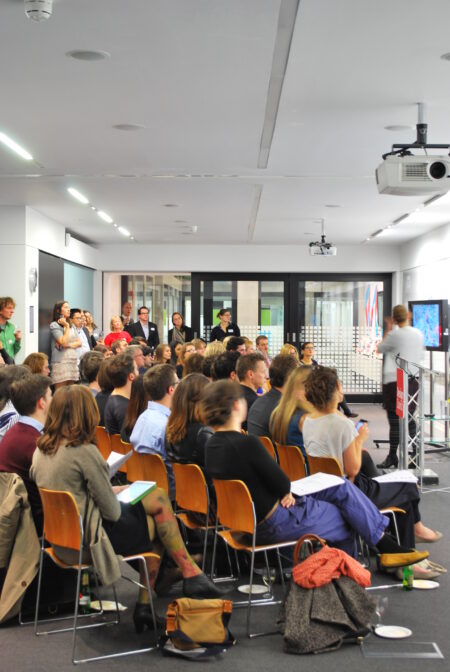
- YU Anniversary Special
A collective and continuing legacy
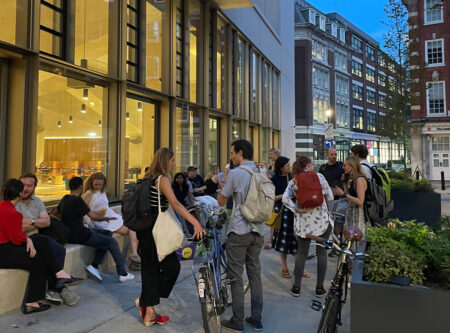
A View and an Agenda

Begin typing your search above and press return to search. Press Esc to cancel.
Privacy Overview
Book Review – The Triumph of the City: How Our Greatest Invention Makes Us Richer, Smarter, Greener, Healthier, and Happier
“The Triumph of the City: …” by Edward Glaesar is an epiphany which throws light upon the driving forces behind the very existence of cities. It shatters the notion of cities being associated with downfall of humankind, and establishes them being spaces of shared knowledge that ultimately shape our well-being. This review is an attempt to bring out significant aspects of the book on central stage. The idea is not to criticise the arguments made by the author, rather to critically examine the nature of those arguments in the present context. The review is divided into three sections. The initial section gives a general overview of the book. It highlights the key ideas that have emerged through the chapters. The second section denotes the shift in author’s argument over the read. And the final section contains the reflection of author’s words from a neutral viewpoint. The impressions from classical literature are taken along with for making any external claims.
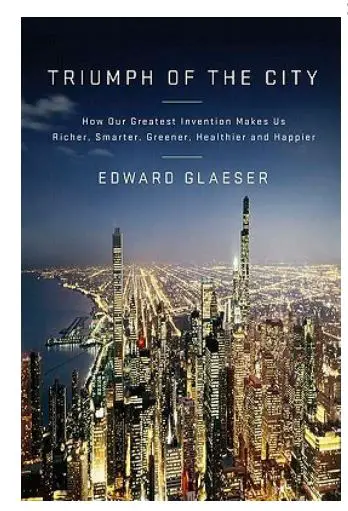
Summary of content
Through the book, the author has tried to illustrate the splendour of cities- calling them our greatest invention of all time. Stating that the majority of world’s population resides in urban areas (and the proportion continues to rise), he conveys that life in cities has been a priority of people over the years (and it remains promising for the future of humankind). All the arguments made further reinforce the greatness of cities- them being manifestations of human interactions. On the following lines, the author has also tried to outshine the cities through their contemporary reflection of poverty, crime, and diseases. With the illustrations of various cities across the world, it is established that cities are a platform of “shared knowledge” and the primary goal of city-life is to provide better life to its people. Drawing the evolution of spaces through classical literature, the author has raised a series of questions- the answers to which are unique for every city taken into consideration.
Some of the key revelations about cities are unveiled in the following order. First, our ability to think and create is enhanced being surrounded by like-minded people. The evergreen boom of Bangalore and Silicon Valley validates the fact- them being the prodigy of bringing knowledge together. Second, modern cities are not mere money-making spaces, rather they are a gateway between markets and culture. The example of Tokyo in harbouring the tradition along with economic development steals the show. Third, not all urban poverty is bad. Considering the case of a person living in Dharavi, he would not have chosen to be there had he any better option with him. More so, the ever-increasing rural to urban migration can be attributed to cities having access to jobs and opportunities. Fourth, an intervention for human capital yields the best return. That is how New York and Detroit turned out so different- the former coming back to life post globalization and the latter getting declined forever. Fifth, the density of a city determines its impact on the environment- smaller the cities, less is the energy requirement and less is the carbon footprint. It can be also thought in terms of saving transportation costs and preserving the suburban belt. And lastly, factors of urban distress pose a real challenge to the cities. An effective governance, however, has the power to shape the cities safe and resilient.
Related Article: Influence on Urban Planning by Kevin A. Lynch , Edward Soja’s Theories of Urban Space
The shift of argument
The book has nine chapters. Through each chapter, the author tries to answers a question establishing a connect between cities and humankind. Throughout, his focus shifts from stating that cities are the auxiliary support of human actions to pointing out various challenges of the city-life. In the first chapter- What Do They Make in Bangalore – the primary argument is that the successful cities are the ones that provide space for meaningful human interactions. Examples of Athens and Silicon Valley are also taken for the same. In the second chapter- Why Do Cities Decline – the author explores the reasons for urban decline. With the instances of New York in 1970s and Detroit under Coleman Young, the author has tried to lay emphasis on the economics and politics of a city’s rise/fall. In the third chapter- What’s Good About Slums – the ideals of economic prospects are reflected in the lives within urban slums. The Favelas of Rio and the American Ghettos have always been a priority location of people irrespective of their shortcomings. In the fourth chapter- How Were the Tenements Tamed – the author contemplates the dusty workplaces to be the engines of cities. Be it the case of Kinshasa or Dharavi, the idea of emerging through crimes and diseases remains the same. In the next chapter- Is London a Luxury Resort – the author has highlighted various economic factors which drive the city. Market forces like division of labour, economies of scale, competition, and affordability are introduced as intrinsic properties of a city. The high-end perceptions of London and New York are illustrated to validate the arguments. In the chapter six- What’s So Great About Skyscrapers – the general notion of going vertical rather than horizontal in development is brought to attention. The redefined zoning regulations of New York and Haussmann’s redevelopment of Paris are two very different cases which point towards the similar objectives. The chapter seven- Why Has Sprawl Spread – talks about the physical out-spill effects of modern cities. The cities of United States are talked about in creating an adverse impact on Housing Infrastructure and Transportation. With the next chapter- Is There Anything Greener Than Blacktop – The argument shifts over the environmental viewpoint in the cities. The consequences of environmentalism and the footprints associated with suburban living are criticized and it is established that life in cities would in fact be greener! Through the instance of India and China, it is further illustrated how the whole world has to pay if the two countries proceed with suburban living. With the last chapter- How Do Cities Succeed – the author directs the whole argument of city life to be better by pointing out successful cities over time. Tokyo (the imperial city); Singapore and Gaborone (the well-managed cities); Boston, Minneapolis, and Milan (the smart cities); Vancouver (the consumer city); Chicago and Atlanta (Growing cities); and Dubai (a peculiar man-made city) are pointed out to demonstrate how people are rich, smart, green, healthy, and happy in them.
A critical note
The hypothesis of the book is very comprehensive in nature. It states that “Cities aren’t structures, cities are people”. To conform to this argument, the author has tried to bring in various illustrations of diverse set of cities from across the world. Starting from detailing out the features that cities to have a better quality of life compared to the rural counterparts, the author has swiftly changed the focus to addressing the rising challenges in the cities in contemporary times. The book has very uniquely brought out the distinct features of cities, yet tried to bind uniformly through the read.
Although, the book also draws several instances from classical literature, there exists a gap (or, an anomaly). The book criticises the instrumental nature of “ Death and Life of Great American Cities ” by Jane Jacobs and suburban viewpoints of Lewis Mumford in “ The City in History: Its Origins, Its Transformations, And Its Prospects ”. Having a previous knowledge of them helps to highlight the fact that this variance from classical literature exists merely because of difference in era- the reviewed book being published in the recent age, and them being published in 1960s. Jacobs did use conceptual tools of her era to understand the success and downfall of American cities. They were not economic in nature, rather social. She constantly pestered on dynamics of diversity within the cities, slumming and un-slumming, gradual and cataclysmic money, and border vacuums. Similarly, Mumford glorified the life in suburbia in early 1900s- with arguments supporting the quality of life with the greens. It is somewhat not reasonable to make a point by standing on (or taking help of) a point of view that was referred to in the previous century. Though it is appreciable that these literary gems are stated in the book, yet for someone not familiar with them would certainly form a sceptical opinion towards them.
Furthermore, the book has also opened horizons towards appreciating the dynamic nature of cities. Some cities succeed in first attempt, and some fail. And some cities bounce back from the worst. It is very difficult to identify the force behind, but the book has equipped with various “kinds” of forces to look at. Sometimes, it is the radical movements which direct the fate of cities. Whether we take an instance of Renaissance in Europe, Industrial revolution in United States, or simply the Globalization. Sometimes, it is the political will. And sometimes, it’s a slow gradual process towards prosperity, or decline. The read has inculcated a sensitivity to such forces.
The conclusion of the book is also very exceptional. Through the conclusion, the author has tried to bring harmony of thoughts by jolting down the points that are open to interpretation of every author like- levelling the playing field, curse of “not in my backyard- NIMBY”, bias towards sprawl, contrast of poor people and places, urbanization through globalization, etc. Lastly, it is the concluding sentence of the book that imparts a sense of an ultimate triumph within the reader- “ London’s ornate arcades or Rio’s fractious favelas, whether in the high-rises of Hong Kong or the dusty workspaces of Dharavi, our culture, our prosperity, and our freedom are all ultimately gifts of people living, working, and thinking together—the ultimate triumph of the city. ”
About The Author
- International edition
- Australia edition
- Europe edition
Triumph of the City by Edward Glaeser – review
A ccording to Harvard economics professor Edward Glaeser, "the city has triumphed". Despite the revolution in information and communication technology and cheap air travel, "more and more people are clustering closer and closer together in large metropolitan areas". In this compelling study of how economic forces shape our cities, Glaeser explains that it is the very closeness of urban life, the opportunity for face-to-face interaction, that makes cities such dynamic and exciting spaces which continue to attract both the poor and the wealthy. Of course, not all cities are thriving. Industrial cities like Detroit are haemorrhaging people. But Glaeser argues such single-industry cities contained the seeds of their own downfall. Diversity and competition are essential and he rejects attempts to reverse urban decline by building art galleries à la Bilbao as "edifice errors". Far better to invest in people's skills: "The real city is made of flesh, not concrete." For creativity, sociability and the love of new ideas lie at the heart of all successful cities.
- Society books
- Architecture

Thérèse and Isabelle by Violette Leduc – review

Paperback Q&A: Jasper Fforde on One of Our Thursdays Is Missing
The war tour by zoe lambert – review, granta: exit strategies – review, death in a cold climate: a guide to scandinavian crime fiction by barry forshaw – review, listening to van morrison by greil marcus.

The Sense of an Ending by Julian Barnes – review
Comments (…), most viewed.

- Latest Posts
- LSE Authors
- Choose a Book for Review
- Submit a Book for Review
- Bookshop Guides
July 18th, 2012
Book review: the triumph of the city by edward glaeser.
0 comments | 1 shares
Estimated reading time: 5 minutes
In The Triumph of Cities , Ed Glaeser takes us around the world and into the mind of the modern city – from Mumbai to Paris to Rio to Detroit to Shanghai, and to any number of points in between – to reveal how cities think, why they behave in the manners that they do, and what wisdom they share with the people who inhabit them. Reviewed by Olmo Silva .
The Triumph of the City. Edward Glaeser. Palgrave Macmillan. March 2011.
Ed Glaeser is Professor of Economics at Harvard University, and is one of the most talented urban economists of our generation. He was among the first to venture down the route of bringing in economics tools to study the functioning of cities. And yet, despite building on years of economic research, his new book is not a tough read filled with economics jargon, equations and statistics. The numbers are there, of course, but so is a vibrant historical perspective which guides the reader through centuries of the rise and fall of cities – from Athens and Venice, to New York, London and Bangalore.
The Secrets of Cities
What are the secrets of cities? In a nutshell, people and proximity. In Glaeser’s own words, “ideas spread more easily in denser places”, and density gives cities an edge over more dispersed places. Entrepreneurial people with bright ideas cluster in urban areas to learn from one another and to realise their potential. And, in a virtuous cycle, cities magnify these people’s talents by stimulating interactions and innovation, and by sharpening entrepreneurial acumen through the forces of competition.
Interestingly, in the age of globalisation and information technology (IT) when everything is just one-click-away, cities are more productive and core to the process of development than ever. As IT has made the ideas we can think of more complex, proximity and face-to-face interactions have become increasingly important in fostering learning and the creation of new ideas. Moreover, global markets imply that what is invented in New York, London or Singapore is sold all over the world, raising the returns to being smart together – i.e. clustering in cities – and inventing the next big thing. So much for the death of distance…
The Dark Side of Cities
Cities have negative aspects too: think of the slums of Mumbai , life in Victorian London , and New York 150 years ago. Crime, congestion, sanitation issues and concentrated poverty are only some of the problems that cities have had – and still have – to confront, while growing and attracting more people. However, argues Glaeser, the presence of urban poverty is a sign of progress: cities do not make people poor! They attract poor people who leave behind rural hardship in search for a bright urban future.
Sure enough, this seems at odds with our perceptions of existence in cities: life in London, New York and Hong Kong is stressful and expensive . However, a growing amount of data suggests that people in cities are not only richer and more productive, but also happier, healthier and living longer. This transformation of cities from places of production to places of consumption and wellbeing does not happen overnight. To prosper, cities need entrepreneurial and educated people, and this applies to the people who are in charge of governing cities too. Indeed, the book presents many examples of successful practices adopted by public officials governing urban agglomerates, as well as cases that turned out to be less of a hit.
The Sunset Boulevard of Cities
Liverpool and Detroit have given us The Beatles and Motown . They have also shined as centres of excellence, thanks to a strategically located harbour (Liverpool) and a world-dominating car industry (Detroit). Yet nowadays they are often associated with urban decline…what has happened? Technology evolved, drastically reducing transport costs and thus Liverpool’s edge as a logistic hub across two continents. The same process of technological change made it possible for Henry Ford to routinise car-production and integrate activities under one single roof in a town-sized plant. While Ford needed the city when learning his trade from other smart entrepreneurs supplying parts and ideas, the company only required abundant ‘cheap space’ when it shifted to mass production: so it moved out of the urban core, leaving it to decline.
These are just two of the many examples of cities on Sunset Boulevard presented in the book. The common lesson is that failing cities are those that have abandoned their core business of attracting clever and entrepreneurial people, as well as their focus on creating ideas. True: some cities have emerged as industrial colossi, but this has been an anomaly. Historically, cities have been made on the fortunes of merchants, with their shrewd, clever and entrepreneurial attitudes. Just think of Amsterdam and Venice centuries ago, and more recently London and New York, as well as the Silicon Valley area and Bangalore, all with their creative sparks of IT genius.
What Have We Learnt?
What is the best way then of making sure cities will continue to prosper? The book contains many clear and well-grounded policy suggestions, although not all will please every reader and policy maker around the world.
First, Glaeser argues for stopping policies that subsidise sub-urban sprawl. These include tax rules that favour ownership of large homes located away from urban centres – such as mortgage interest rate deductibility – and road-building without road-use charging – which encourages long commutes, congestion and pollution. In this, London and the UK are ahead of their times: mortgage tax deductions were abolished in the 1990s and the London Congestion Charge (introduced in 2003) successfully reduced congestion and promoted the use of public transport. Surely enough, as we make suburbs less attractive, we need to make life in cities more appealing. This includes improving urban infrastructures, in particular schools – a prime concern for many urban families – and public transport systems.
The second and more controversial policy recommendation Glaeser makes is to “build up, not out”: skyscrapers with mixed-use space, part offices/part flats, such as The Shard , are the way forward. This is because they increase density – therefore fostering interaction and innovation, and because, perhaps counter-intuitively, high-rise cities are greener than sub-urban sprawl. Think of all those tiny, tightly spaced urban flats, as opposed to those vast, hard-to-heat country-side mansions… Or of those urban commuters packed on a bus, as opposed to sub-urban workers driving alone in their cars along (mainly) toll-free roads.
However, the most controversial policy advice is that the solution to urban decline is to stop worrying about places, and to start focusing on people. At the end of the day, cities are just the people who live there, and making sure they are endowed with a worthwhile education and are able to follow their route to success is what policy should be all about. Of course, they might move out in search of a brighter future: good for them! Still, the best solution for the cities that have been great in the past and are struggling to shine again is to scale down their ambitions and focus instead on improving their people’s chances of success, no matter where this leads them.
Undeniably, these are hard points to sell. Yet the book is a gripping journey through the life and death of cities, convincingly arguing that “our greatest invention(s)” really have the potential to make us all “richer, smarter, greener, healthier and happier”.
Listen to a podcast of Edward Glaeser’s recent talk at the LSE, or watch a video from the event.
This review was originally published on the British Politics and Policy blog on 17th April 2011.
——————————————————————————————-
Olmo Silva is Lecturer in Real Estate Economics and Finance at the London School of Economics .

About the author
Leave a Reply Cancel reply
Related posts.

Book Review: The Struggle for Iraq’s Future: How Corruption, Incompetence and Sectarianism Have Undermined Democracy by Zaid Al-Ali
August 5th, 2014.

Book Review: The South Africa Reader: History, Culture, Politics edited by Clifton Crais and Thomas McClendon
April 2nd, 2014.
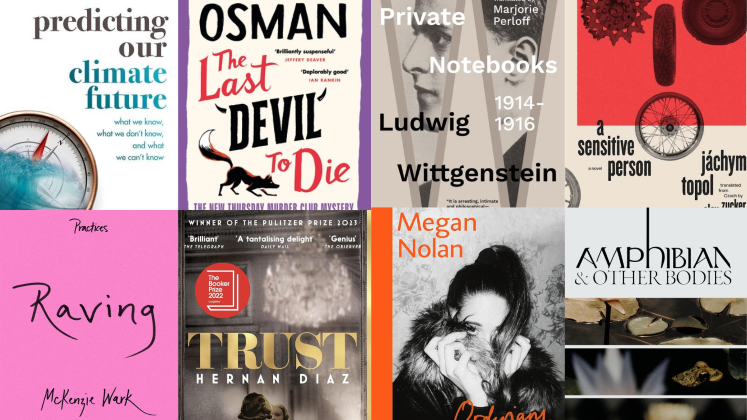
Eight of the best books of 2023, recommended by LSE blog editors
December 20th, 2023.
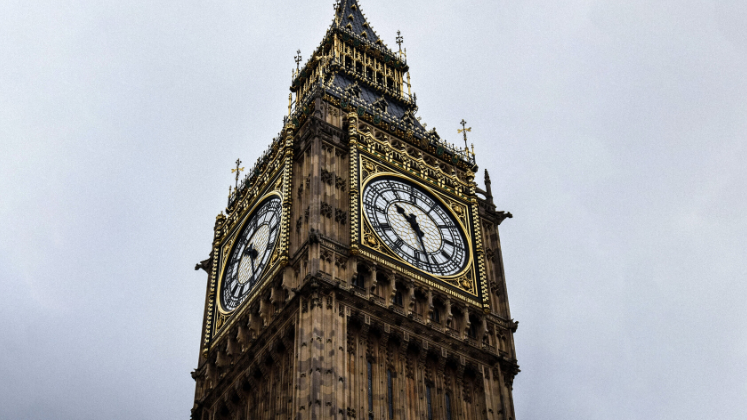
Book Review: Legislation at Westminster: Parliamentary Actors and Influence in the Making of British Law by Meg Russell and Daniel Gover
December 12th, 2017, subscribe via email.
Enter your email address to subscribe to this blog and receive notifications of new posts by email.
Email Address
Book Review: Triumph of the City by Edward Glaeser
by Lindsay M. Miller, Senior Fellow at The National Civic League

Urbanists everywhere are discussing the “return to the city,” or the re-urbanization of suburbanites and the increasing importance of density in economic development and growth. In his book, Triumph of the City: How Our Greatest Invention Makes Us Richer, Smarter, Greener, Healthier, and Happier , Harvard economist Edward Glaeser champions this trend, arguing that urban life is better for humanity economically, socially, and in almost every other way.
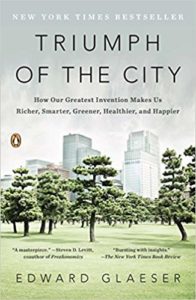
Whether examining the slums of Kolkata or the high-end stores of Fifth Avenue, Glaeser’s book does a good job of showing the bright side to urbanization, no matter where we find it. Some of his most important insights challenge our most prominent preconceptions about cities. For example, he argues that, while admittedly the source of much suffering, not all urban poverty is bad. Cities attract the poor because they are centers of economic mobility, and the “flow of less advantaged people into cities from Rio to Rotterdam demonstrates urban strength, not weakness.” Urban poverty should not be compared to urban wealth, he argues, but to rural poverty, which is often much worse.
Another counter-intuitive insight Glaeser makes is that cities are good for the environment, and the environmentalist notion of living amongst the land and the trees is misguided. The best things we can do to reduce our carbon footprint, he argues, is to live in smaller homes, walk or take public transit to work, and rid ourselves of NIMBYism when it comes to new development in temperate climates.
Glaeser’s celebration of cities is hopeful, and his challenges to the status quo are sorely needed. One weakness of his book is that he sometimes so unabashedly supports urban growth that he can downplay some of its externalities. Urban poverty may be better than rural poverty when it comes to economic opportunity, but he should not so quickly dismiss the harsh realities of urban struggle.
What’s more, as an economist, Glaeser sometimes waves off the human element. From an economic standpoint, it may be obvious that restricting contemporary buildings in older cities like London and Paris has some negative impact. Yet, to downplay the historical and cultural value of their rich architecture negates our topophilia —or deep sense of love and connection—to place.
Glaeser’s book is timely, important, and relevant to urbanists and non-urbanists alike. To celebrators of urbanism, his book gives you grit. For anti-urbanists, or those fighting against its negative externalities, the book gives insight to the other side. For all of us, the book presents some cogent truths — whether we choose to embrace them or not.
[1] https://www.theatlantic.com/business/archive/2017/12/developing-world-city-size-urbanization/548468/
Share This Story
Some related posts, activating citizenship and democratic renewal through deliberation: the launch of fide – north america, welcome the league’s newest board members, news media restructuring: new inequities and democracy’s impact, thank you to our key partners.
- The All-America City Award
- National Conference on Local Governance
- Community Assistance
- The League’s Health Equity Award
- Truth, Racial Healing and Transformation
- All-America Conversations
- Promising Practices
- Mission and Vision
- Account Information
Triumph of the City

50 pages • 1 hour read
Triumph of The City: How Our Greatest Invention Makes Us Richer, Smarter, Greener, Healthier, and Happier (2011)
A modern alternative to SparkNotes and CliffsNotes, SuperSummary offers high-quality Study Guides with detailed chapter summaries and analysis of major themes, characters, and more.
Chapter Summaries & Analyses
Introduction-Chapter 2
Chapters 3-4
Chapters 5-6
Chapters 7-8
Chapter 9-Conclusion
Key Figures
Index of Terms
Important Quotes
Essay Topics
Discussion Questions
Summary and Study Guide
Harvard economics professor Edward Glaeser brings new life and controversy to the study of urban areas with his book Triumph of The City: How Our Greatest Invention Makes Us Richer, Smarter, Greener, Healthier, and Happier (2011). The 2011 Penguin Books edition is the subject of this guide.
Glaeser amasses evidence from his own research and elsewhere to prove the critical importance of cities to the progress of humanity. His thesis is that the many personal interconnections that take place in dense metropolises generate good ideas that lead to greater economic productivity, better opportunities for the poor, more creativity in arts and entertainment, and an environmentally greener way of life than is possible in rural or suburban areas.
Since ancient Athens, cities have been idea factories. Today, the leading urban centers of innovation—Bangalore in India, Silicon Valley in California, as well as New York, Boston, London, Hong Kong, and Singapore—attract educated workforces and lots of small, innovative businesses where ideas translate into new goods and services. Once-great manufacturing cities like Detroit became too dependent on a few large industries and were unable to remake themselves when factories no longer needed masses of laborers. Some, like New York and Boston, managed comebacks by reconfiguring themselves as centers of innovation, where person-to-person interactions proved vital to the growth of productivity. Key to this makeover is education: A well-schooled workforce is more creative and prosperous.
Cities worldwide attract the poor because urban centers offer better opportunities than rural regions. In a well-functioning city, poverty is a sign of success (the urban poor tend to rise out of poverty; they’re replaced by newcomers who follow in their footsteps). In urban centers where the poor become ensnared and unable to move up, the problem usually lies with bad governance. The best things city leaders can do are provide clean water, sanitation, functioning transit systems, competent policing, and good schooling. In Western countries, disease and crime have come down over the past century, and those cities are now safer than the countryside.
Arts and entertainment thrive in the crowded give-and-take of city life. Enticing arts scenes and buzzing nightlife are selling points for cities that wish to attract the best-educated workers. On the other hand, young artists’ access to lively downtowns becomes blocked when restrictions on urban construction cause living expenses to go up. What should go up instead are skyscrapers, whose efficient use of limited acreage helps reduce the cost of city life. Locals often resist high-rises, fearing overcrowding and a loss of neighborhood character, but tall buildings designed with plenty of ground-floor shops and entertainment generate a vibrant street life of their own.
In the US, many policies encourage people to leave cities for suburbia. The mortgage-interest tax deduction makes home ownership more valuable, while federal support for highway construction makes it easier to work in town and live in the suburbs. However, large suburban home sizes and long commutes increase energy costs and pollution. Meanwhile, attempts to limit construction in greener states shift housing demand to browner areas, which worsens overall environmental damage. Cities, on the other hand, reduce per-person environmental impacts with densely built neighborhoods and shorter commutes. Wooded urban parks and enhanced entertainment options remedy some of the quality-of-life issues that drive residents to the suburbs.
Every city is unique, and each succeeds in its own way. Some, like Hong Kong and Singapore, emphasize good governance and free markets; others, like Boston and Minneapolis, feature excellent universities; still others, like Paris and Dubai, offer urban pleasures. Many municipalities have become centers of finance and technology; some cities are known for the physical beauty of their locale.
Even successful cities struggle under misaligned public policies that restrict their growth while propping up dying areas. Restrictions on trade and immigration also blunt the vibrancy urban life. Meanwhile, if developing nations copy Western policies that encourage suburban sprawl, the world will face vastly increased environmental burdens.
Big cities, then, are idea factories that lead to increased productivity, improved opportunities for the poor, and reduced environmental impact. Cities are vital to the progress of human civilization; if not supported by public policy, public police should at least not constrain them.

Don't Miss Out!
Access Study Guide Now
Triumph of the City: How Our Greatest Invention Makes Us Richer, Smarter, Greener, Healthier, and Happier (Book Review)
:max_bytes(150000):strip_icc():format(webp)/Lloyd-Alter-bw-883700895c6844cf9127ab9289968e93.jpg)
- University of Toronto
fanjianhua / Getty Images
- Environment
- Business & Policy
- Home & Design
- Current Events
- Treehugger Voices
- News Archive
I have written a number of posts where I complain about Edward Glaeser. Being a heritage activist, I have objected to his attitudes about preservation. Being a Torontonian, I have resented his criticism of our sainted Jane Jacobs. Being a supporter of urban farming, I was appalled by his article in the Boston Globe.
But since his book, Triumph of the City, came out in February, he has been everywhere, the contrarian for hire, attacking the conventional wisdom. I thought that if I was going to keep complaining about him, I had better read his book.
Glaeser goes beyond Richard Florida's "Cities are hip" and David Owen's "Cities are green." His premise is stated in the subtitle, that cities make us "Richer, Smarter, Greener, Healthier, and Happier." He also thinks that cities should be denser and cheaper; the more people, the better. He is an economist, and not a sentimentalist. That is the root of his problem with preservation; those leafy old low-rise neighbourhoods restrict the supply of housing and increase its cost. As for Jane Jacobs, she thought saving old buildings would preserve affordability, whereas her cheap Greenwich Village apartments of 50 years ago are now only affordable for hedge fund managers. He writes:
Preservation isn't always wrong- there is much worth saving in our cities- but it always comes at a cost.
He has a point; Paris, London and Manhattan are lovely to look at, but only the very rich can afford to live there. However, one might ask if the rich would still want to live there if it looked like Houston.
Glaeser correctly notes that transportation technologies have always determined urban form, and that the current car-based model is an environmental disaster. But there are good reasons that people do it:
Exoriating the exurbs is a popular intellectual pastime, but the people who move to the suburbs aren't fools. The friends of the cities would be wiser to learn from Sunbelt sprawl than to mindlessly denigrate its inhabitants.
In fact, Glaeser points out that for many people, living in the suburbs is cheaper and more convenient, thanks to an elaborate and mostly free highway system, convenient and free parking, and subsidized home ownership courtesy of mortgage interest deductibility. In much of America, commuting by car is faster than any other mode. It is such a rational thing to do that Glaeser himself, like David Owen before him, writes about the Triumph of the City while living in the suburbs.
There is a lot in this book makes me crazy. Glaeser wants to remove restrictions that prevent people from building just about anything, anywhere, suggesting that this will increase density in our cities and reduce the cost of housing. In fact, it would probably have the opposite effect, as greenbelts and protected lands get chewed up for more sprawl; we would probably just get Houston, everywhere. He thinks knocking down all those five storey buildings and replacing them with 40 storey buildings will reduce our carbon footprint, when in fact in so much of New York and other cities, there are vast areas of one and two storey buildings that could be replaced with five storey buildings. New York isn't just Manhattan, and its overall density is rather low when you average it over all of the boroughs. There is a lot of room to grow without demolishing Greenwich Village.
But he also attacks the anti-urban bias in federal policies, from infrastructure investment to income tax, and calls for a carbon tax. It adds up to a powerful argument for a sort of free-market environmentalism: If people had to pay the true cost of the carbon they emit, then they would live where they emit the least carbon, which is in cities.
Glaeser summarizes the entire book in one powerful paragraph in the introduction; all the rest is commentary.
The strengh that comes from human collaboration is the central truth behind civilization's success and the primary reason why cities exist. To understand our cities and what to do about them, we must hold on to those truths and dispatch harmful myths. We must discard the view that environmentalism means living around trees and that urbanites should always fight to preserve a city's physical past. We must stop idolizing home ownership which favours suburban tract homes over high-rise apartments, and stop romanticizing rural villages. We should eschew the simplistic view that better long-distance communication will reduce our desire to be near on another. Above all, we must free ourselves from our tendency to see cities as their buildings, and remember that the real city is made of flesh, not concrete.
I am not persuaded; I rather think that flesh comes and goes, but that great buildings, and great cities, endure. But I am impressed.
- Is the Age of the Skyscraper Over? (It Should Be)
- 2022 in Review: The Year E-Cargo Bikes Took Over
- The 15-Minute City Needs Small Business Saturday ... Every Day
- Are Context Cities the New Smart Cities?
- Meet the 'Social Omnivore'
- Our Urban Problems Aren't Caused by Restrictions on Density, but by Inequality
- Bill McKibben Calls for Slow Travel
- Empowering Communities to Protect Their Ecosystems
- Touring the Gutsy and Green PostGreen Homes in Philadelphia
- What Is the True Cost of Car Ownership?
- The 1.5-Degree Climate Goal Is As Essential As Ever
- This Mass Timber Passivhaus Rental Building Is Perfect for Active Adults
- Austin Maynard Grows Up With New Sustainable Multifamily Apartment Project
- The 15-Minute City Is Having a Moment
- 26 Climate Actions Cities Should Adopt at COP26 for Climate Change Resilience
- What's the Right Way to Build in a Climate Crisis?
We've detected unusual activity from your computer network
To continue, please click the box below to let us know you're not a robot.
Why did this happen?
Please make sure your browser supports JavaScript and cookies and that you are not blocking them from loading. For more information you can review our Terms of Service and Cookie Policy .
For inquiries related to this message please contact our support team and provide the reference ID below.

This website uses cookies.
You need to be logged in to view this member page.
Please log in or sign up .
Book Review - IELTS Reading Answers
Table of Contents
Book review - ielts reading passage, book review - question and answers.
The "Book Review" passage of the IELTS reading section includes a reading passage related to task 2 with three distinct question types, appropriate answers, and explanations. By utilising this practice exam, you can evaluate your performance, correct your mistakes, and devise a plan to complete the reading test in the allocated time. So, let’s begin with the blog!
The reading test has 60 minutes to finish. To complete the 1–14 questions in this section, allow yourself 20 minutes. Before answering the questions, thoroughly read the passage. Book Review IELTS reading answers are provided for you to compare with your responses and assess your performance.
Book Review
The Happiness Industry: How the Government and Big Business Sold Us Well-Being By William Davies
Richard Layard, an economist and advocate of "positive psychology," has summarised the ideologies and faith of various people nowadays in his proclamation that "happiness is the ultimate goal because it is self-evidently good. If we are asked why happiness matters, we can give no further external reason. It is just evident that it matters." For Layard and others like him, the goal of government is to foster an environment of shared prosperity. The only issue is how to attain it, and here positive psychology—a purported science that not only detects what makes individuals happy but also lets their happiness be quantified - may indicate the way. With the guidance of this study, governments, as per theorists, are currently more capable than ever before of ensuring harmony in society.
It is an incredibly primitive and simplistic style of thinking, yet it is rising in popularity due to this. The huge philosophical literature that has studied and challenged the meaning and worth of happiness is neglected by those who embrace this mind-set, and they write as if no significant ideas had been studied on the subject prior to their realisation. The emergence of this method of thinking was due in large part to the work of philosopher Jeremy Bentham (1748–1832). For Bentham, it was apparent that happiness and the lack of misery constitute the human good. In the 4th century BC, the Greek philosopher Aristotle connected happiness with self-realisation, and scholars throughout the years attempted to combine the goal of happiness with other human virtues, although all of this was just metaphysics or fiction to Bentham. Modern proponents of positive psychology follow in his footsteps, condemning as obsolete and unnecessary almost the entire ethical reflection on human pleasure to date, despite knowing nothing about him or the school of moral theory he founded—as they are ignorant in the history of ideas due to education and philosophical conviction.
However, as William Davies points out in his new book, The Happiness Industry, assuming that happiness is the prime self-evident good restricts moral analysis. This rich, clear, and compelling book's ability to contextualise the modern cult of happiness inside a precisely defined historical context is one of its many merits. Davies was correct in his assessment of Bentham, recognising that he was significantly more than just a philosopher. According to Davies, Bentham engaged in activities that modern-day management consultants serving the public sector may partake in. In the 1790s, he addressed letters to the Bank of England with a model for a printing machine that could generate unforgeable banknotes and to the Home Office with a suggestion that the government's various departments be interlinked by a system of "conversation tubes." To preserve food like meat, fish, fruit, and vegetables, he designed a "frigidarium." His renowned plan for a jail known as a "Panopticon," in which inmates would be confined in solitary while always being monitored by the guards, came extremely close to being implemented. (Interestingly, Davies does not address the fact that Bentham envisioned his Panopticon to serve as a model for both a jail and a control mechanism that could be utilised in both schools and factories.)
Also read: What is the IELTS Vocabulary?
Bentham also established the "science of happiness." If happiness is to be considered a science, then it must be quantified. Bentham presented two methods for measuring happiness. He proposed that pleasure might be measured by taking the average heart rate of a person and seeing happiness as a complex of pleasant emotions. As an alternative, the value of money might be used as the criterion for quantification: if the cost of two distinct products is the same, it can be stated that both give the customer the same amount of happiness. The latter attribute grabbed Bentham's eye more. According to Davies, Bentham "established the foundation for the combination of psychological study and capitalism, which would influence the activities of the twentieth century," by associating money so intimately with inner experience.
In the book The Happiness Industry, it is explained how the pursuit of a science of pleasure has merged with business. We learn a lot of interesting information on the redefining and treatment of economic concerns as psychological conditions. Additionally, Davies demonstrates how management studies and advertising have been influenced by the idea that inner joy and dissatisfaction can be assessed objectively. The inclination of philosophers like J. B. Watson, the pioneer of behaviourism*, was that managers and politicians could mould or influence people. Watson's theories on human nature were not backed by any facts. He had only conducted studies on white rats when he was appointed president of the American Psychological Association in 1915. He had "never really examined a fellow human being." The government in Britain has founded a "Behaviour Insights Team" to research how individuals might be motivated to live in ways that are thought to be socially desirable while incurring the lowest expenses to the public purse. However, Watson's reductive model has already been extensively adopted.
To keep people motivated in their work, modern industrial nations seem to require the potential for ever-increasing happiness. But regardless of its conceptual heritage, the theory that authorities ought to be in charge of fostering happiness is always hazardous to people's freedom.
* behaviourism: a field of psychology in which focus is on observable behaviour
Also checkout: 15 Best IELTS Preparation books in 2024
Questions 1-3
Choose the correct letter, A,B,C or D.
Write the correct letter in the boxes 1-3 on your answer sheet.
1. The critic mentions the Greek philosopher Aristotle, to state that happiness ______.
Is not something that should be fought for.
May not be just pleasure and the absence of pain.
Is not just an abstract concept.
Should not be the main goal of humans.
2. In Davies' opinion, the suggestion that was given by Bentham’s to link the prices to happiness was remarkable because _____.
It established a connection between work and psychology.
It involved consideration of the rights of consumers.
It was the first successful way of assessing happiness.
It was the first successful example of psychological research.
3. What is the reviewer’s opinion on the proponents of positive psychology?
They have a fresh new approach to ideas on human happiness.
They are wrong to reject the ideas of Bentham.
They are ignorant about the ideas they should be considering.
They are over-influenced by their study of Bentham’s theories.
Answer 1: B
Explanation 1: According to the 2nd paragraph, 6th line, For Bentham, it was apparent that happiness and the lack of misery constitute the human good. In the 4th century BC, the Greek philosopher Aristotle connected happiness……….. This was just metaphysics or fiction to Bentham. These lines discuss Bentham's belief that happiness is solely about pleasure and lacks pain. On the other hand, Aristotle held the opposite view, contending that happiness is more complex than mere contentment and absence of suffering. Thus, the correct option is B.
Answer 2: A
Explanation 2: In the 5th line of the 4th paragraph, the beliefs put forward by Jeremy Bentham are described by author Davies. There was also a link made between the costs and happiness. He clarifies Bentham's theory, according to which "the joy received from both of them would be equal if the price of two items is the same." He says that Bentham was the first to establish the link between psychology and business. Thus, the response is yes.
Answer 3: C
Explanation 3: In the 1st line of the 2nd paragraph, they have clarified that this specific concept of happiness was quite well-known despite being incredibly basic and impolite. It is further said that these proponents frequently exhibit obliviousness, which is the tendency to reject the research's explanation of the literal meaning and worth of happiness before they even acknowledge the concept.
Also read: Preface to how the other half thinks - IELTS Reading Answers
Questions 4-8
Complete the summary using the list of words A-G below.
Write the correct letter, A-G, in the boxes 4-8 on your answer sheet.
Jeremy Bentham
Jeremy Bentham was active in other areas besides philosophy. In the 1970s he suggested a type of technology to improve 4…………. for different Government departments. He developed a new way of printing banknotes to increase 5…………. and also designed a method for the 6……….. of food. He also drew up plans for a prison which allowed the 7…………. of prisoners at all times, and believed the same design could be used for other institutions as well. When researching happiness, he investigated possibilities for its 8………… and suggested some methods of doing this.
communication
preservation
implementation
measurement
observation
Answer 4: B
Explanation 4: In the 8th line of the 3rd paragraph, in the 1790s, he addressed letters to the Bank of England with a model for a printing machine that could generate unforgeable banknotes and to the Home Office with a suggestion that the government's various departments be interlinked by a system of "conversation tubes."
Answer 5: C
Explanation 5: According to the 8th line of the 3rd paragraph, he suggested the Bank of England develop a printing press that could create unforgeable banknotes. In other words, since the notes wouldn't be copied, the security will be enhanced. Security is the solution as a result.
Answer 6: D
Explanation 6: In the 12th line of the 3rd paragraph, “To preserve food like meat, fish, fruit, and vegetables, he designed a "frigidarium." This statement suggests that he had prepared strategies and techniques for preserving perishable foods. Thus, option D—preservation—is the correct response.
Answer 7: G
Explanation 7: According to the 13th line of the 3rd paragraph, This line describes how Bentham designed a prison called ‘Panopticon’, a celebrated design. He had built it so the jailer could see the inmates from every angle when confined in a cell. Thus, option G, observation, is the correct response.
Answer 8: F
Explanation 8: In the 1st line, 4th paragraph, “Bentham also established the "science of happiness." If happiness is to be considered a science, then it must be quantified.” the author claims to be the father of the science of happiness and holds the view that anything that might be deemed scientific could potentially be measured. Therefore, F is the correct option.
Also read: Is passing the IELTS reading test too tough?
Questions 9-14
Do the following statements agree with the claims of the writer in the Reading Passage?
In the boxes 9-14 on your answer sheet, write
YES if the statement agrees the claims of the writer
NO if the statement contradicts the claims of the writer
NOT GIVEN if it is impossible to say what the write thinks about this
9. Industrialisation is connected to the requirement of happiness.
10. Prior to 1915, Watson conducted study on people that supported his theories of behaviourism.
11. Government’s main objective should be to increase the population’s happiness.
12. The Happiness Industry’s strength is the discussion of the connection between psychology and commerce.
13. The theories by Watson had immense influence on the governments outside America.
14. Certain emotions are more challenging to measure than others.
Answer 9: Yes
Explanation 9: According to the 1st line, 6th paragraph, “To keep people motivated in their work, modern industrial nations seem to require the potential for ever-increasing happiness.” It is said that happiness is necessary to inspire employees, and it is related to the business sector. The answer is true since the statement and the passage's line are consistent.
Answer 10: No
Explanation 10: According to the 5th paragraph, 8th line, “Watson's theories on human nature were not backed by any facts. He had only conducted studies on white rats when he was appointed president of the American Psychological Association in 1915.” All of the rats he experimented on were white. As a result, the assertion does not agree. So, the answer is no.
Answer 11: No
Explanation 11: According to the 2nd line of the 6th paragraph, “But regardless of its conceptual heritage, the theory that authorities ought to be in charge of fostering happiness is always hazardous to people's freedom.” The author believes that people's freedom is in jeopardy if the government decides to enhance individuals' happiness. He disagrees with the notion that it should be the goal of the state.
Answer 12: Yes
Explanation 12: In the 1st line of the 5th paragraph, “In the book The Happiness Industry, it is explained how the pursuit of a science of pleasure has merged with business. We learn a lot of interesting information on the redefining and treatment of economic concerns as psychological conditions.” The assertion is consistent with the scripture. Therefore, the answer is yes.
Answer 13: Not Given
Explanation 13: The passage's 5th paragraph explains how the governments adopted many of Watson's concepts in an effort to effect "behaviour change." It does not mention their influence or that only governments outside of America have accepted it, though.
Answer 14: Not Given
Explanation 14: In Paragraph 5th, the topic of measuring emotions is brought up, but no details are given about how or even where different emotions should be measured. As a result, no response is provided.
Also Check: What's the right study plan for IELTS preparation?
In conclusion, we would like to say that consistent practice with various reading passage types can improve your comprehension of the text's actual content and quicken your reading pace, which will improve your exam results.
If you want to get further details on how to prepare for IELTS or, particularly, the IELTS Reading section, you can contact the Prepare IELTS exam (PI) expert counsellors for additional guidance. Our team of education experts is dedicated to providing you with the best test material and guidance to ace the IELTS exam . You can get a one-on-one counselling session and an IELTS online practice test via our platform. Contact us at [email protected] or call us at +91 9773398388 for further queries.

Boost your IELTS Speaking score
Latest News

Describe a time when you felt bored IELTS speaking cue card
2024-04-24 17:22:08

IELTS Speaking test - Most commonly garble words
2024-04-17 13:04:02

IELTS Score for New Zealand
2024-04-16 14:56:18

IELTS Score You Need for Admission in Europe
2024-04-13 12:34:11

Top Universities Accepting IELTS Scores
2024-04-12 15:54:24

IELTS Writing Vocabulary - Topic Wise Word List
2024-04-11 15:43:35

Describe a Time When You Needed to Use Your Imagination - IELTS Speaking Cue Card
2024-04-11 14:33:23

MBA Colleges Accepting IELTS Scores
2024-04-10 16:04:57

Describe a piece of good news - IELTS speaking cue card
2024-04-10 15:04:29

IELTS Exam Syllabus: Exam Format and More
2024-04-09 16:49:48

Related Blogs
A php error was encountered.
Severity: Notice
Message: Undefined variable: tips_category
Filename: Blog/blog_detail.php
Line Number: 383
File: /home/prepareieltsexam/public_html/application/views/frontend/Blog/blog_detail.php Line: 383 Function: _error_handler
File: /home/prepareieltsexam/public_html/application/controllers/Tips.php Line: 545 Function: view
File: /home/prepareieltsexam/public_html/index.php Line: 316 Function: require_once
Severity: Warning
Message: Invalid argument supplied for foreach()

IELTS Speaking test - Most commonly garble words Since Indian students are writing and speaking in English with Indian accent, with not much exposure to foreign accent, it can be the cause of
- (5.0 /152 votes)

IELTS Score for New Zealand Since Indian students are writing and speaking in English with Indian accent, with not much exposure to foreign accent, it can be the cause of

IELTS Score You Need for Admission in Europe Since Indian students are writing and speaking in English with Indian accent, with not much exposure to foreign accent, it can be the cause of

Top Universities Accepting IELTS Scores Since Indian students are writing and speaking in English with Indian accent, with not much exposure to foreign accent, it can be the cause of
Registration Now

Share Your Feedback
Free 1 day ielts class with our head of ielts program nick carey.
Register on the spot and get 10% Discount on IELTS fee!
Achieve IELTS Success with Our Comprehensive Classes, proven teaching methodology, and Experienced Teachers.
Affordable Fee Structure
Experienced & Certified Trainers
Interactive Class Activities
Friday, 2nd Feb 2024
11:00 AM - 4:00 PM

IELTS ONLINE TEST
IELTS READING PRACTICE TESTS
Book Review IELTS Reading Answers with Explanation
Luyện tập đề IELTS Reading Practice với passage Book Review được lấy từ cuốn sách IELTS Cambridge IELTS Practice Test 13 - Test 4 - Passage 3 với trải nghiệm thi IELTS trên máy và giải thích đáp án chi tiết bằng Linearthinking, kèm list từ vựng IELTS cần học trong bài đọc.

📖 Bài đọc (reading passage)
❓ câu hỏi (questions), 🔥 answer key (đáp án và giải thích), giải thích chi tiết.
Thông tin trong bài đọc
an economist and advocate of ‘positive psychology’ summarises the beliefs of many people today...
It (= positive psychology) is an astonishingly crude and simple-minded way of thinking
=> Nếu ko có vốn vocab rộng vẫn có thể đoán rằng: tác giả cho rằng positive psychology là 1 cách nghĩ simple - đơn giản, ko bao hàm nhiều thứ.
Those (= advocates of positive psychology) who think in this way are oblivious to the vast philosophical literature
IELTS Reading Practice
Gồm làm đề, xem giải thích chi tiết, học từ vựng của những bài thi IELTS Reading phổ biến nhất trên thị trường
Bài viết liên quan
Should we try to bring extinct species back to life ielts reading answers with explanation.
Luyện tập đề IELTS Reading Practice với passage Should We Try To Bring Extinct Species Back To Life? được lấy từ cuốn sách IELTS Cambridge IELTS Practice Test 15 - Test 2 - Passage 2 với trải nghiệm thi IELTS trên máy và giải thích đáp án chi tiết bằng Linearthinking, kèm list từ vựng IELTS cần học trong bài đọc.

Nutmeg – A Valuable Spice IELTS Reading Answers with Explanation
Luyện tập đề IELTS Reading Practice với passage Nutmeg – A Valuable Spice được lấy từ cuốn sách IELTS Cambridge IELTS Practice Test 15 - Test 1 - Passage 1 với trải nghiệm thi IELTS trên máy và giải thích đáp án chi tiết bằng Linearthinking, kèm list từ vựng IELTS cần học trong bài đọc.

Gifted Children And Learning IELTS Reading Answers with Explanation
Luyện tập đề IELTS Reading Practice với passage Gifted Children And Learning được lấy từ cuốn sách IELTS Cambridge IELTS Practice Test 10 - Test 2 - Passage 2 với trải nghiệm thi IELTS trên máy và giải thích đáp án chi tiết bằng Linearthinking, kèm list từ vựng IELTS cần học trong bài đọc.

Climate Change Reveals Ancient Artefacts In Norway's Glaciers IELTS Reading Answers with Explanation
Luyện tập đề IELTS Reading Practice với passage Climate Change Reveals Ancient Artefacts In Norway's Glaciers được lấy từ cuốn sách IELTS Cambridge IELTS Practice Test 16 - Test 3 - Passage 2 với trải nghiệm thi IELTS trên máy và giải thích đáp án chi tiết bằng Linearthinking, kèm list từ vựng IELTS cần học trong bài đọc.

Measures To Combat Infectious Disease In Tsarist Russia IELTS Reading Answers with Explanation
Luyện tập đề IELTS Reading Practice với passage Measures To Combat Infectious Disease In Tsarist Russia được lấy từ cuốn sách IELTS Practice Test Plus 3 - Test 3 - Passage 2 với trải nghiệm thi IELTS trên máy và giải thích đáp án chi tiết bằng Linearthinking, kèm list từ vựng IELTS cần học trong bài đọc.

Một sản phẩm thuộc Học viện Tiếng Anh Tư Duy DOL English (IELTS Đình Lực) - www.dolenglish.vn
Trụ sở : Hẻm 458/14, đường 3/2, P12, Q10, TP.HCM
Hotline : 1800 96 96 39
Inbox : m.me/dolenglish.ieltsdinhluc
Theo dõi DOL tại
- Practice Test
- Useful Tips – Tricks
- Full Writing Review
- General Writing Task
- Writing Task 1
- Writing Task 2
- Writing Exercises
- Writing Sample – Topics
- Writing Vocabulary
- Speaking Vocabulary
- Intro Question
- Speaking Part 1
- Speaking Part 2
- Speaking Part 2 – Audio
- Speaking Part 3
- IELTS Books
- Recent Exams
- IELTS Vocabulary
- Essay from Examiners
- IELTS Ideas
IELTS App - For Mobile
Ready for the IELTS exam with our IELTS app. Over 2 million downloads

Popular Last 24h
Describe a person whom you met for the first time and made you happy, list of top 100 synonyms in the ielts test, describe a film that made you laugh, [ebook] collins for ielts – reading, writing, listening, speaking and vocabulary, ielts writing task 2: sugar-based drinks, describe an intelligent person, in many countries,today there are many highly qualified graduates without employment..
- IELTS Test/Skills FAQs
- IELTS Scoring in Detail
- Forecast Speaking – 2023
- List IELTS Speaking Part 3
- List IELTS Speaking Part 1
- IELTS Writing 2023 – Actual Test
Our Telegram
Join our community for IELTS preparation and share and download materials.
The information on this site is for informational purposes only. IELTS is a registered trademark of the University of Cambridge ESOL, the British Council, and IDP Education Australia. This site and its owners are not affiliated, approved or endorsed by University of Cambridge ESOL, the British Council, or IDP Education Australia.
Latest Articles
Ielts speaking part 3: topic teamwork, describe a time when someone did well in a team, writing task 2: problem and solution, writing task 2: government| health care vs tax-payers, writing task 1: languages learned by two genders, most popular, topic: experience is the best teacher, describe something difficult you would like to succeed in doing.
ieltspracticeonline All Rights Reserved

IMAGES
VIDEO
COMMENTS
This post can simply guide you the best to figure out every Reading answer without trouble. Finding IELTS Reading answers is a step-by-step routine and I hope this post can assist you in this topic. Cambridge 13 Reading Test 4 Passage 3: The headline of the passage: Book Review. Questions 27-29: (Multiple Choice Questions)
Edward Glaeser, a Harvard professor of economics, has spent several decades investigating the role cities play in fostering human achievement. In "Triumph of the City," he has embedded his ...
Triumph of the City Edward L. Glaeser Triumph of the City SuperSummary 1 Table of Contents S UM M A RY 3 C H A P TER S UM M A RIES & A N A LYS ES 5 Introduction-Chapter 2 5 Chapters 3-4 11 Chapters 5-6 17 Chapters 7-8 21 Chapter 9-Conclusion 26 K EY FIG URES 31 Edward Glaeser 31 Jane Jacobs 31 Coleman Young 31 William Levitt 31 A. E. Lefcourt 32 Baron Haussmann 32 Henry Ford 32 Frederick ...
The Triumph of the City. Edward Glaeser. Macmillan. March 2011. Find this book: Ed Glaeser is Professor of Economics at Harvard University, and is one of the most talented urban economists of our generation. He was among the first to venture down the route of bringing in economics tools to study the functioning of cities.
Ten Years after its original publication Nicholas Falk rereads this hugely influential book following a visit to Coventry, finding much wisdom but remaining frustrated that we still find these seemingly obvious ideas so difficult to implement.. Re-reading Ed Glaeser's thrilling account of what makes cities successful on the same day I returned to Coventry, the UK's current City of Culture ...
The conclusion of the book is also very exceptional. Through the conclusion, the author has tried to bring harmony of thoughts by jolting down the points that are open to interpretation of every author like- levelling the playing field, curse of "not in my backyard- NIMBY", bias towards sprawl, contrast of poor people and places, urbanization through globalization, etc. Lastly, it is the ...
PD Smith. Tue 28 Feb 2012 06.58 EST. A ccording to Harvard economics professor Edward Glaeser, "the city has triumphed". Despite the revolution in information and communication technology and ...
Why I liked "Triumph of The City". The central theme of this book focuses on cities and their ability to improve the way we live. Although the author made numerous interesting and compelling arguments, I found his writing style a little too academic for my liking. Be that as it may, the author's methodical approach and 30+ page ...
About Triumph of the City. Shortlisted for the Financial Times and McKinsey Best Book of the Year Award in 2011 "A masterpiece." —Steven D. Levitt, coauthor of Freakonomics "Bursting with insights." —The New York Times Book Review A pioneering urban economist presents a myth-shattering look at the majesty and greatness of cities
12 December 2016. Book Review. Katrie Lowe
Estimated reading time: 5 minutes. In The Triumph of Cities, Ed Glaeser takes us around the world and into the mind of the modern city - from Mumbai to Paris to Rio to Detroit to Shanghai, and to any number of points in between - to reveal how cities think, why they behave in the manners that they do, and what wisdom they share with the ...
If you were to take nothing else from TRIUMPH OF THE CITY, you should attend to its cri de coeur: "the real city is made of flesh, not concrete." ... Reiss, David J., Book Review: Edward L. Glaeser, Triumph of The City: How Our Greatest Invention Makes Us Richer, Smarter, Greener, Healthier, and Happier (The Penguin Press 2011) (December 5 ...
Glaeser's book is timely, important, and relevant to urbanists and non-urbanists alike. To celebrators of urbanism, his book gives you grit. For anti-urbanists, or those fighting against its negative externalities, the book gives insight to the other side. For all of us, the book presents some cogent truths — whether we choose to embrace ...
Triumph of the city: How Our Greatest Invention Makes Us Richer, Smarter, Greener, Healthier, and Happier is a non-fiction book by Edward Glaeser, a noted economist who is the Fred and Eleanor Glimp Professor of Economics at Harvard University.. First published in 2011 by the Penguin Press, the book presents an in-depth look at the important role cities play in human progress and prosperity.
for only $0.70/week. Subscribe. Thanks for exploring this SuperSummary Study Guide of "Triumph of the City" by Edward L. Glaeser. A modern alternative to SparkNotes and CliffsNotes, SuperSummary offers high-quality Study Guides with detailed chapter summaries and analysis of major themes, characters, and more.
Triumph of the City. Offers a readable, agenda-setting account of how and why cities function as they do and why so many of us choose to live in them. The author takes us around the world and into the mind of the modern city, to reveal how cities think, why they behave in the manners that they do, and what wisdom they share with the people who ...
But since his book, Triumph of the City, came out in February, he has been everywhere, the contrarian for hire, attacking the conventional wisdom. ... 2022 in Review: The Year E-Cargo Bikes Took ...
Triumph of the City. How Our Greatest Invention Makes Us Richer, Smarter, Greener, Healthier, and Happier. Edward Glaeser. 978--14-312054-4. $19.00 US. Paperback. Penguin Books. Jan 31, 2012. Survival of the City.
Triumph of the City: How Our Greatest Invention Makes Us Richer, Smarter, Healthier and Happier. By Edward Glaeser. Penguin Press; 352 pp; $29.95. The city, Rousseau once suggested, is "the abyss ...
IELTS Reading: Read the excerpt from a book review and decide whether the statements are true, false or not given.
Overview. The "Book Review" passage of the IELTS reading section includes a reading passage related to task 2 with three distinct question types, appropriate answers, and explanations. By utilising this practice exam, you can evaluate your performance, correct your mistakes, and devise a plan to complete the reading test in the allocated time.
Luyện tập đề IELTS Reading Practice với passage Book Review được lấy từ cuốn sách IELTS Cambridge IELTS Practice Test 13 - Test 4 - Passage 3 với trải nghiệm thi IELTS trên máy và giải thích đáp án chi tiết bằng Linearthinking, kèm list từ vựng IELTS cần học trong bài đọc. ... Book Review ...
IELTS Reading Practice 106: Book Review. The Happiness Industry: How the Government and Big Business Sold Us Well-Being. By William Davies. 'Happiness is the ultimate goal because it is self-evidently good. If we are asked why happiness matters we can give no further external reason. It just obviously does matter.'.